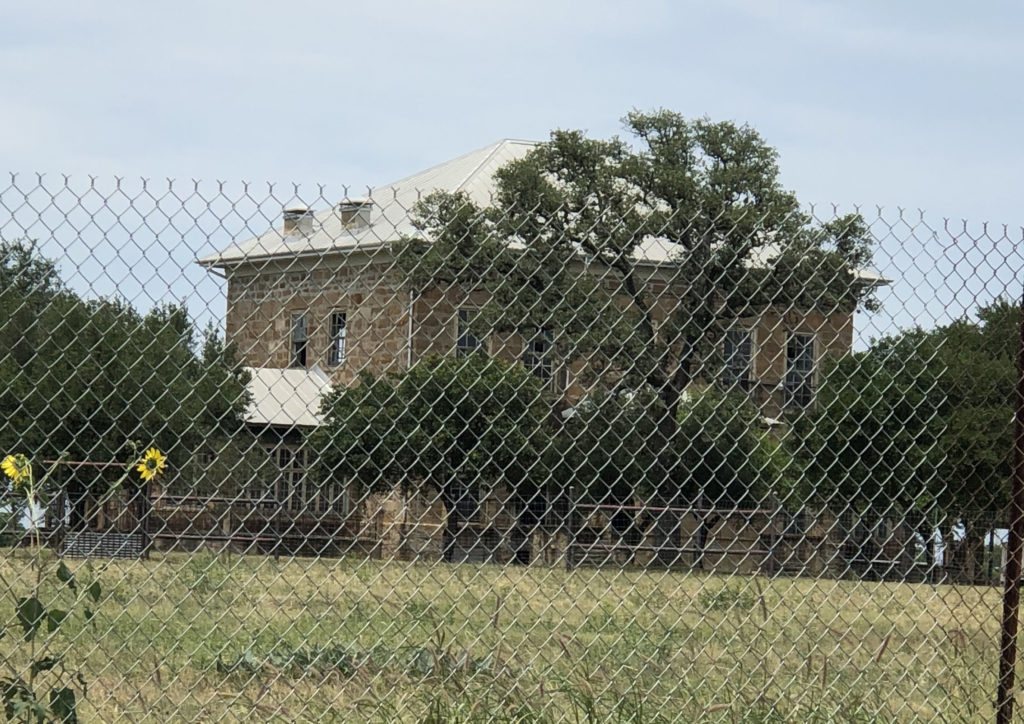
The community of Von Ormy is named for Count Norbert von Ormay, an Austrian nobleman who arrived in the area in 1886 “with twenty servants,” according to the TSHA (Texas State Historical Association), and purchased what became known as the “Castle on the Medina.”

The report is that the arrival of the count and his wife, Countess Emma “was a sensation in San Antonio” and was often the subject of the gossip pages in the San Antonio Evening Light. (TSHA) Referred to even to this day as the Von Ormy Castle – complete with intrigue and mystery – it is a large, limestone, Pennsylvania-style house overlooking the south bank of the Medina River. It is on the site of a ranch house complex that was built by Ignacio Perez who, in 1809, had received a large land grant south of the Medina River.
Prior to the count’s arrival, in 1861, Enoch Jones, a San Antonio merchant and land speculator who had opposed Texas’ secession and the Confederacy, closed his mercantile store on San Antonio’s Main Plaza and retired to his “Castle on the Medina,” which he had built around 1856 one mile east of present-day Von Ormy in a community known as Garza’s Crossing, located at the intersection of Old Somerset Road and the Medina River. When Jones died in 1863, his surviving wife raised her family in the castle and eventually sold it to Count Norbert von Ormay in 1885. She used the funds to open a German-English school for girls in San Antonio where she and a sister taught for many years. Interestingly, the count and his entourage remained there for less than a year and a half before making a hasty departure, leaving his affairs unresolved, ostensibly for the count to claim an inheritance in Brazil. (TSHA)
In its beginnings, Garza’s Crossing was a ranching community. In the mid 1760s, a Manuel Ruiz de Pesia founded the earliest known cattle ranch there. Blas Maria Herrera, who rode by horse from Laredo to San Antonio to warn the town of Santa Anna’s approach, was the first settler of the area. Many of the Garza’s Crossing residents – and most of whom were ranching families – supported the Texas Revolution. (An exception is Ignacio Perez, who remained loyal to Mexico.) These families included Navarro, Ruiz, Herrera, Hernandez, Ruiz de Casteneda, and Bacerra, all who served in the Texan Army. Following Texas’ independence, the Ruiz-Herrera Ranch formed the community with related members. They built a Catholic church, and in 1850, Miguel de la Garza established a ferry across the Medina River to service the new stagecoach line between San Antonio and Laredo and for supply trains of the United States Army on the Comanche frontier. Miguel de la Garza married the daughter of Blas Herrera and moved to the Ruiz-Herrera Ranch, and it is at this time that the area became known as Garza’s Crossing, or “Paso de las Garzas.”

Also interesting historically is the Santa Anna Oak, a large live oak under which General Santa Anna – who had become familiar with the area during the Mexican War of Independence – encamped prior to making his final march on the Alamo. According to UTSA studies, the live oak is 12’ in diameter and is estimated to be over 600 years old. It is located on the banks of the Medina just east of Von Ormy on the Alamo River Resort, a family-owned RV and camping resort.
When in 1881 the International-Great Northern Railroad constructed the first rail line connecting San Antonio and Laredo, it included a rail bridge across the Medina, one mile west Garza’s Crossing. Subsequently, the area surrounding the rail depot on the south bank of the Medina grew quickly, its early settlers of the newly formed community coming mostly from Garza’s Crossing. The IGNR called the community Medina Crossing, and a postmaster by the name of Branson Bywater relocated the Mann’s Crossing post office, which was located about a mile west, to the new location near the rail depot and re-named the community “Von Ormy”, misspelling the name of Count von Ormay. The post office remained in this building even into the mid 1960s, after which time it was moved to the highway, US 81, which became IH35.
Mann’s Crossing was another important settlement that contributed to the Von Ormy community. Located at the intersection of Old Pearsall Rd. and the Medina River, it is named after the Mann family who immigrated to Texas from Alsace-Lorraine as part of the original Henri Castro Colony. Mann’s Crossing is on part of the land granted to Sam McCullouch, Jr., a free Black soldier who had served in the Texas Revolution and then settled in the area in 1852.
The Von Ormy community grew, and in early 1900, the Von Ormy School opened adjacent to the post office, and classes were provided through the eighth grade. In 1914, the Von Ormy Cottage Sanitarium opened to treat tuberculosis patients. By then, the town, with a population of 350, had two grocery stores, a general store, and a cotton gin. In 1919, the Santisima Trinidad Catholic Church, which was located at Garza’s Crossing, was destroyed by a hurricane, and it was rebuilt along the Medina River in Von Ormy in 1930. In 1952, the Von Ormy School closed, and the students began attending the newly-formed Southwest Rural School District, establishing a large campus at Mann’s Crossing.
The population of the Von Ormy community – which had remained unincorporated – declined following WWII, reporting only around 100 residents in the mid 1960s. But by the year 2000, its population had grown to around 1300 residents with some twenty businesses. The City of Von Ormy was incorporated on May 30, 2008, and it included parts of the original Garza’s Crossing and Mann’s Crossing.